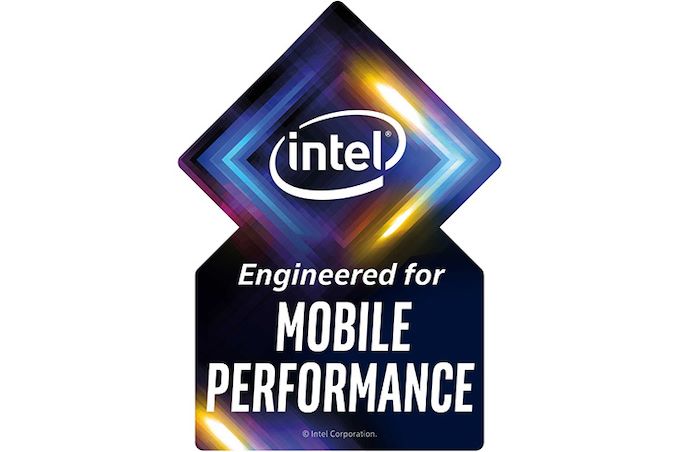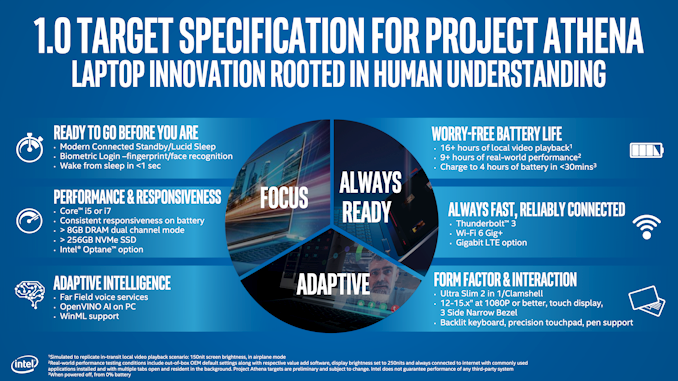Intel Unveils ‘Engineered for Mobile Performance’ Badge for Project Athena Program
by Anton Shilov on August 12, 2019 12:00 PM EST- Posted in
- Notebooks
- Intel
- Laptops
- Ice Lake
- Project Athena
- 10th Gen Core

With the release of the first Ice Lake-U laptops, Intel has announced that there will be a badge/visual identifier for laptops that comply with Intel's Project Athena standard. The ‘Engineered for Mobile Performance’ label will be used for online listings, product pages, on in-store display systems, on packaging, and for demonstrations. Do note, however, that there won't be any ‘Engineered for Mobile Performance’ badges on actual notebooks. Apparently, neither Intel nor PC makers want to put badges on the chassis of premium computers (this itself typically being treated as a premium feature).
Stylized like a medal, Intel’s ‘Engineered for Mobile Performance’ label indicates that a particular notebook meets Intel’s key experience indicators (KEI) for Athena laptops, which stipulate requirements for performance, features, and battery life, among other things. As previously announced, Intel is doing Athena verification itself, so any product carrying the label means that it has been verified by Intel’s tests and conducted by Intel’s specialists.
With the Athena specifications set to be revised every year, for this first year’s ‘Engineered for Mobile Performance’ notebooks that comply with the Project Athena v1.0 specification, Intel wants the following.
| Intel Project Athena v. 1.0 Requirements | ||
| Feature | Requirement | |
| Form-Factor | An ultra-thin clamshell or convertible notebook, or a 2-in-1 hybrid PC. | |
| Display | Touch-enabled 12 – 15-inch display with narrow bezels. At least a Full-HD resolution. Stylus support |
|
| Internal Hardware | Intel’s 10th Gen Core i5 or Core i7 processor with Intel Dynamic Tuning Technology. At least 8 GB of dual-channel DRAM. At least a 256 GB NVMe SSD with or without Optane H10 caching SSD. |
|
| Responsiveness | Consistent responsiveness both on battery and on power outlet. | |
| Instant Action | Connected Standby/Lucid Sleep support. Wake up from sleep in less than a second. Wake up to Internet browsing time should not exceed two seconds. |
|
| Wireless Connectivity | Wi-Fi 6 and optional Gigabit LTE. | |
| Wired Connectivity | Thunderbolt 3. | |
| Battery Life | At least 9 hours of mixed-workload battery life at 250 nits display brightness. At least 16 hours of local video playback. Fast charge support. |
|
| Intelligence | Far Field microphone with voice services. Hardware-accelerated OpenVINO AI and WinML support (which requires Ice Lake). |
|
| Interaction | Backlit keyboard, precision touchpad, touch display, stylus. | |
While the PC notebook market is (and will remain) widely varied in features, performance, and prices, Intel is ultimately aiming to tighten up the high-end portion of the market by giving its OEM/ODM partners goals, and matching incentives to reach them. PC hardware in general has been a continual race to the bottom – OEMs are always looking for an edge in costs/price – so in this respect Athena is an effort to entice OEMs to use higher-quality, more expensive (and frequently all-Intel) parts for better performance and greater energy efficiency. Intel is no stranger to this strategy, having employed something similar for both their Centrino and Ultrabook programs, so they are once again turning to it to shape the direction of high-end laptops going into 2020, as well as fending off a push from Arm-based laptops.
The first laptop to meet Intel’s Project Athena program requirements is Dell’s XPS 13 2-in-1 model 7390 that became available on August 8. Shortly, Acer’s Swift 5, HP’s Envy 13 Wood Series, and Lenovo’s Yoga S940 will also make their debut.
Related Reading:
- Intel's Project Athena: Defining The Next Generation Of Premium Laptops
- Intel Unveils 10th Gen Core Ice Lake-U & Ice Lake-Y Mobile CPUs: 10nm Sunny Cove Later This Year
- Examining Intel's Ice Lake Processors: Taking a Bite of the Sunny Cove Microarchitecture
Source: Intel











49 Comments
View All Comments
Irata - Tuesday, August 13, 2019 - link
I do own an AMD laptop as a matter of fact and it's a very nice one (Huawei Matebook with a Ryzen 2500U). Performance is great - kid can play Fortnite on it smoothely, it's very well built and configured, overall smooth and has an excellent battery life. All this for a very good price.Huawei used the same case, screen, battery... as on their Intel counterpart and offers it for a very good price (lower than a comparable Intel model).
Now they did wait to release it worldwide until the Intel based successor (with better specs but much higher price) was released but it shows that if you want to, you can build a great Ryzen based notebook.
So yes, I do blame OEM for there not being more good AMD based notebooks.
An there is demand - when it was released, it made it to #1 on Amazon's laptop sale charts in the UK and Germany and it is currently still on the #2 spot in Germany (currently not available from Amazon UK)
edzieba - Monday, August 12, 2019 - link
AMD would have to abandon their one-platform approach to mobile chips to do so.They adopted it in the Bulldozer days to make their mobile chips remotely appealing (allow the high-end chips to be mated to the most bargain-basement platform, to encourage OEMs to make the bargain-basement platform in the first place), but sales remained poor enough that OEMs had no desire to put the R&D effort into higher end platforms that would never make back the investment. If AMD were to explicitly split their mobile chips into two platforms, it would force the higher end chips to be mated to suitable platforms. Of course, it could also backfire if OEMs do not expect sales of high end Ryzen notebooks to be high enough to pay off the R&D for an additional platform.
neblogai - Monday, August 12, 2019 - link
I meant it in a different way- AMD would not split their chips into platforms- the same lineup of their chips would be used, only laptops themselves would try to qualify for certain criteria, and be awarded a tier. That would help ensuring that laptops that are otherwise fine do not cut corners in critical areas. Because, in midrange, buying a laptop often reminds a game 'where will I be fooled'. Too often now laptops sell certain specs, but hide too many weak areas in their design, and drive the market further in the way of 'lemon market'. But qualification, and less lemons would make AMD laptops easier to recommend.Irata - Tuesday, August 13, 2019 - link
I guess meeting the requirement is probably tied to certain cash incentives from Intel and given AMD's more limited funds, I'd rather AMD invest this in R&D.That said, if AMD were to provide some engineering support in terms of platform building for notebooks that would be a step forward but I am not sure if building great AMD notebooks (OEM could already do this now) would not pose the risk of losing funding / support from Intel.
silverblue - Tuesday, August 13, 2019 - link
AMD's past attempt at this (Vision... way to confuse *slow clap*) was pretty poor. I understand what they were trying to do, in the sense that it informed the user what the machine should be able to do rather than giving specs, however this unfortunately leaves the certification open to OEMs offering products that satisfy minimum requirements which, as we know, are a world away from recommended requirements (just think games).It's a huge shame that AMD won't launch Zen 2 mobile offerings for a few months; with Zen resurrecting their fortunes, they could've worked out their own badging system with OEMs sticking to a list of specs, and they would probably sell a few nowadays.
eastcoast_pete - Monday, August 12, 2019 - link
I agree with most of these "requirements", except for the touchscreen. I go out of my way to avoid them on laptops (don't like smudges on my screen), and rather look for a good touchpad and keyboard.eastcoast_pete - Monday, August 12, 2019 - link
Also, it will be interesting to see how these measure up versus the "always-connected" Qualcomm 8cx notebooks. As for AMD, many of us are waiting to see their Zen 2 or 2+ mobile chips. But many of us can only wait that long.ciparis - Monday, August 12, 2019 - link
"precision touchpad"From your lips to God's ears. Thank you, Intel!
"touch display"
Well, you can't have everything.
poohbear - Monday, August 12, 2019 - link
I think this is a great way for standardization at the high end and transparency for the consumer. Most consumers don't have a clue which laptop is which. Now we can reference this badge when recommending laptops to help them make a more informed decision.poohbear - Monday, August 12, 2019 - link
wait is the touchscreen an actual requirement?? Making that a requirement makes no sense on a laptop!!! Especially for those of us that use it for work!